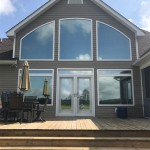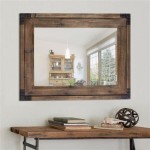What Height Should a Full-Length Mirror Be Hung?
Determining the optimal height for hanging a full-length mirror is crucial for achieving its intended function: providing a complete and accurate reflection of the person using it. This seemingly simple task involves considering several factors, including the height of the individuals who will primarily use the mirror, the mirror's dimensions, and the aesthetic of the surrounding space. An improperly positioned mirror can be both visually unappealing and practically ineffective, failing to provide a full view or creating awkward reflections.
The primary objective is to position the mirror so that it captures a complete head-to-toe reflection for the majority of users. However, a universally perfect height is unattainable, as individuals vary significantly in stature. Therefore, a compromise is often necessary, aiming for a height that accommodates the average user while still being visually balanced within the room.
Before physically hanging the mirror, careful planning and measurement are essential. Ignoring these steps can result in unnecessary holes in the wall and a sub-optimal placement that requires re-adjustment. Consider the following key aspects to ensure the mirror is hung at the most appropriate height.
Calculating Ideal Height Based on User Height
The most important factor in determining the hanging height of a full-length mirror is the height of the individuals who will regularly use it. The general rule of thumb is to position the mirror so that the midpoint of the mirror aligns with the average eye level of the primary users. This ensures that the face is clearly visible without requiring excessive tilting or stooping.
To calculate the ideal height, first determine the eye level of the primary users. This can be achieved by measuring their height and then measuring from the floor to their eyes. If there are multiple users, calculate the average eye level. For example, if one person is 5'4" (64 inches) with an eye level of 60 inches and another person is 6'0" (72 inches) with an eye level of 68 inches, the average eye level would be (60 + 68) / 2 = 64 inches.
Once the average eye level is determined, consider the height of the mirror itself. Locate the midpoint of the mirror. The goal is to position the mirror so that this midpoint aligns with the average eye level calculated earlier. This will ensure that the reflection is centered and provides the most complete view.
For a practical example, imagine a 60-inch tall mirror. The midpoint is at 30 inches from either the top or bottom edge. If the average eye level is 64 inches, the bottom edge of the mirror should be hung 34 inches above the floor (64 inches - 30 inches = 34 inches). This places the midpoint of the mirror precisely at the average eye level.
It is important to note that this calculation provides a starting point. Minor adjustments may be needed based on personal preferences and the specific characteristics of the mirror and the room.
Accounting for Mirror Size and Style
The dimensions of the mirror significantly influence its optimal placement. A very tall and narrow mirror requires a different hanging height than a shorter, wider mirror. Additionally, the style of the mirror, particularly the presence of a decorative frame, can impact the perceived center and overall visual balance when mounted on the wall.
For taller mirrors, it might not be possible to adhere strictly to the eye-level rule, particularly in rooms with standard ceiling heights. In these cases, prioritize capturing the full body reflection, even if the face is slightly higher in the frame. It is generally preferable to have the bottom edge of the mirror closer to the floor than to have the top edge nearly touching the ceiling.
Wider mirrors offer more flexibility in terms of vertical positioning. They can often accommodate a broader range of heights without significantly compromising the reflected image. The width of the mirror also contributes to the overall aesthetic balance within the room. A wider mirror can make a small space feel larger and more open, while a narrower mirror might be better suited for a more confined area.
The frame surrounding the mirror should also be considered. If the frame is particularly ornate or visually substantial, it might influence the perceived center of the mirror. In such cases, it might be necessary to make minor adjustments to the hanging height to ensure that the entire composition, including the frame, appears balanced and visually appealing.
Mirrors that lean against the wall offer a different set of considerations. While they do not require hanging, their positioning still needs careful thought. The bottom edge of the mirror should rest securely on the floor, and the top edge should lean against the wall at a slight angle. The angle of the lean will affect the viewing angle and the amount of floor space the mirror occupies.
Addressing Practical Considerations and Room Aesthetics
Beyond the user's height and the mirror's dimensions, practical considerations and the overall aesthetic of the room play a crucial role in determining the optimal hanging height. Factors such as the presence of furniture, the location of electrical outlets, and the desired style of the room can all influence the final decision.
When hanging a mirror in a bedroom or dressing area, consider the placement of nearby furniture such as dressers, chairs, or benches. The mirror should be positioned so that it is easily accessible and provides a clear view without obstruction. Avoid placing the mirror behind furniture, as this defeats its purpose and can create a cluttered appearance.
The location of electrical outlets and light switches can also affect the placement of the mirror. Avoid covering these features with the mirror, as this can be inconvenient and potentially hazardous. If necessary, adjust the hanging height to ensure that these features remain accessible.
The overall aesthetic of the room should also be taken into account. The mirror should complement the existing décor and contribute to the desired style. For example, in a minimalist room, a simple, frameless mirror might be the best choice. In a more traditional room, a mirror with an ornate frame could be more appropriate.
Consider the lighting in the room. The mirror should be positioned to reflect natural light or artificial light in a way that enhances the space. Avoid placing the mirror directly opposite a window, as this can cause glare and create an uncomfortable viewing experience. Instead, position the mirror to reflect light from a nearby window or lamp, which can brighten the room and create a more inviting atmosphere.
Finally, it is always advisable to temporarily hold the mirror in place before permanently hanging it. This allows for a visual assessment of the placement and provides an opportunity to make any necessary adjustments. Use a level to ensure that the mirror is hung straight, and double-check all measurements before drilling any holes. By carefully considering these practical and aesthetic factors, the mirror can be placed at the most advantageous height, enhancing both its functionality and its contribution to the overall design of the room.

Length And Placement Of Mirror To See Whole Using Ray Tracing

Shortest Mirror To See Full Length Of Your

Where To Hang A Full Length Mirror Seriously Happy Homes

How To Hang A Heavy Full Length Leaner Mirror On The Wall House Of Hepworths

How High Should These Mirrors Be Hung

How To Hang A Heavy Full Length Leaner Mirror On The Wall House Of Hepworths

Shortest Mirror To See Full Length Of Your

Tips On How High To Hang A Mirror Interior Design Blog Hadley Court

How To Hang A Heavy Full Length Leaner Mirror On The Wall House Of Hepworths

Where To Hang A Full Length Mirror Seriously Happy Homes








